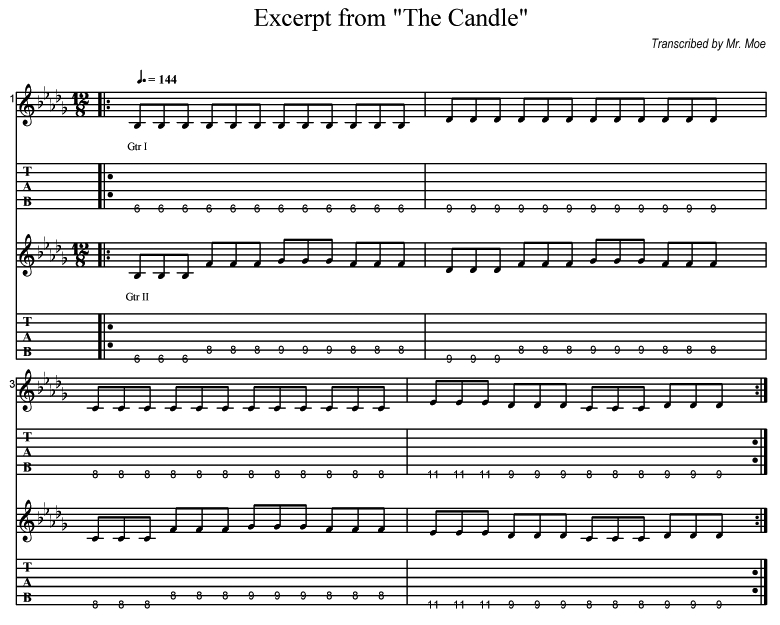Hi, full-time shredders! This is my first column here and I hope you enjoy it.
In this article, we're going to see how some simple guitar overdubs can be very effective and contain a lot of musical information. Below is an excerpt of a song from one of my favorite bands, King Diamond. These are the first guitar measures from a song called "The Candle", from his first album "Fatal Portrait". This piece features Andy La Rocque and Michael Denner on the guitars.
The first guitar is performed by Andy and the second by Michael. This riff is repeated a lot throughout the song and we're going to think of the first guitar as the "lead riff" and the second as the "overdub riff", since this is their tonal function here. The lead gives the root note, while the overdub adds a perfect fifth (V) and a minor sixth (bVI), then coming back to the perfect fifth again on the first measure. Then, on the second measure, you have a major third/perfect forth/major third interval and on the third one, you have a perfect forth/diminished fifth/perfect forth. After that, both guitars play the same melodic line, to end the riff.

MP3 - Song Excerpt
This is quite simple to play. You just have to watch your pick attack and your pick hand muting to make sure it will sound clear and have that "metal-violence" that the piece requires, also called "mojo" by many others.
OK, but thinking more about the musical information, we'll see (or listen) a bit deeper. Listening to both guitars together on the first measure, it seems kinda weird on the third tempo. That's due to the minor sixth (bVI) and not only because it appears, but also because it comes after the perfect fifth (V) and then comes back at it again, executing a half-tone interval, which naturally creates tension by itself, and creates even more tension when you have the root causing these notes to be a V and an bVI. This is caused by the harmonic function implied by the root note.
I know I've said a lot already, but if you got here, maybe you'll find the time to read a little bit further. If we don't get "squared" and limit our thoughts only to the harmonic function spoken above, we'll find out that another way to see the interval between the root and the minor sixth is the inversion of a major third, right? This will give you a Bb as the major third of Gb in this case (first measure). I heard and read somewhere that it's the fifth that "strengthens" the chords, but if you get to play with another guitarist, try a metal-based line, overdubbing chords using this technique: the lead plays the root and the other plays the same chord with the major third on the bass. Just monitor your distortion levels and pick hand muting to make sure it will sound clear.
There are even more things here. The other measures bring more overdubs which can generate more research and information, following the example above. Also, pay attention to the time signature of 12/8. It's almost the same as a 4/4 in the sense that it presents four beats per measure but what differs is the natural subdivision of each tempo - being a compound time signature, each beat is naturally divided by three not by two like on simple ones - and that's why we don't transcribe the notes as triplets.
By the way, after that it gets even better! On the ninth measure, they play the same riff, changing the tonality from Bb minor to G minor. To play it just do the same riff starting one and a half step down on the sixth string of your guitar - on the root of the new tonality. Well, you've been warned: a lot of information.
Thanks for taking the time to read this, hope you learned something, until next time!
Mr. Moe is a Brazilian guitar player living in Sao Paulo and has been studying music from the age of 10. He is very dedicated to his work and growth as a musician - especially as a guitar player and composer.
As a guitar player, his biggest influence is Steve Vai. As a composer, his influences don't come only from music but also from books and movies.
He is currently recording songs for his debut solo album of all original material.
